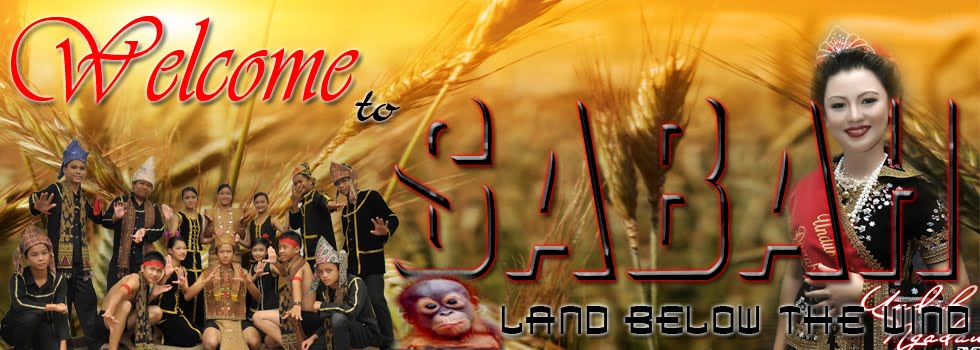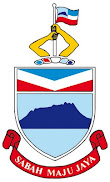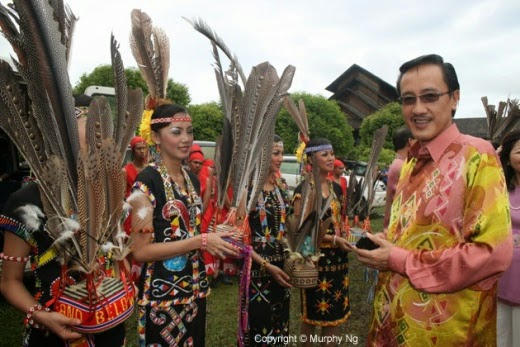Gomantong Caves - Sabah
>> Rabu, 4 Disember 2013
It was March and one of the highlights on the tour itinerary was a visit to the Gomantong Caves on the way to Sukau and the Kinabatangan Wildlife Sanctuary. The stopover at the caves was to be only for a couple of hours or so.
Our 82km or 2 hr road trip from Sandakan was smooth enough and all was going well. We were dry and comfy in the van, the rainclouds were wringing down copious amount of rain and a friendly conversation was getting along with the other guests on the trip. There were only 3 of us on this tour and it was nice not to be cramped in with a large group. Then the driver took a turnoff towards Kampung. Sukau ( Sukau Village ) and traveled on for another 20 kms (12.4 miles) on a bumpy offroad to the main entrance of the caves. Little did we know that the 20km this boneshaker ride was only a teaser to the remaining trip ahead of us.It was March and one of the highlights on the tour itinerary was a visit to the Gomantong Caves on the way to Sukau and the Kinabatangan Wildlife Sanctuary. The stopover at the caves was to be only for a couple of hours or so.
Our 82km or 2 hr road trip from Sandakan was smooth enough and all was going well. We were dry and comfy in the van, the rainclouds were wringing down copious amount of rain and a friendly conversation was getting along with the other guests on the trip. There were only 3 of us on this tour and it was nice not to be cramped in with a large group. Then the driver took a turnoff towards Kampung. Sukau ( Sukau Village ) and traveled on for another 20 kms (12.4 miles) on a bumpy offroad to the main entrance of the caves. Little did we know that the 20km this boneshaker ride was only a teaser to the remaining trip ahead of us.Collection of birds' nests and the value of this produce have been recognised for as long as the Chinese djongs and ships sailed these waters and that dates back to the 13th Century. Before licensing was put into effect, the harvesting of birds' nests in the caves was managed by families on a rotational basis and the rights were inherited and passed down for generations. These days, the licensing is issued by the Wildlife Department, is based on tenders and costs about RM300,000 per harvest season. Under the Birds' Nest Ordinance and the Forest Enactment of 1968, heavy fines are imposed on unlicensed collectors. These birds' nests are so valuable that during non harvesting seasons, guards are posted at the cave to stop any poaching.Gomantong is one cave that is definitely worth a visit but one must make sure that the visit coincides with the harvesting seasons of the swiftlets' nests which happen to be from February to April and from July to September.
The first harvest period coincides with the swiftlets' breeding season and ends before nesting begins. Harvesters collect the existing nests which prompts the swiftlets to construct new nests. The Black-Nest Swiftlets build nests with bits of feather, crumbs of moss / lichen and droppings mixed in with the saliva These dark coloured nests are considered of poor quality. The Edible-nest Swiftlet, on the other hand, build nests that are purely from their saliva. The white nests are smaller than of the Black-Nest Swiftlets but by far more valuable. Per kg of this quality will cost approximately USD1,000 - USD2,000 in the open market. The swiftlets build their nest at night, after a day out searching for food. The new nest will take about 30 to 35days to complete and once that's done, and the mother lays a maximum of 2 eggs which she broods for 1 month. When the fledglings are old enough to leave the nest, the harvesting season begins again. The harvesters must make sure that the nests are collected only after they are abandoned by the young swiftlets.But get this, the most prized birds' nest are the reddish brown nests believed to be saliva mixed with blood which the bird expels during nest building. It is thought to be highly nutritious. Researchers have found that contrary to this belief, the colour is derived from the oxidation of iron which results in rust. Rust definitely does not have nutritious value!
Swiftlets build their nests at least 10m above ground but in lofty caves such as at Gomantong, the nests are some 90m above the cave floor. Harvesting is a tricky business. The harvesters have to constantly maintain and mend the rattan and bamboo ladders used to reach the nests 90 - 100m high.
The first cave is known as Simud Hitam ( Black Cave ). Nests collected are of poorer quality. Further up from this cave is another called Simud Putih ( White Cave ), the larger of the two caves. This is located some 90m above Simud Hitam and is a treacherous climb. Anyone wanting to visit Simud Putih will have to apply for permit to do so and getting into the cave takes 5 hours. The prized white nests are found here.For a season's harvest, the worker gets a salary of RM3,500, ridiculously low for a task so dangerous but it is a lot of money to the locals. Once the nests are collected, it is carefully packed in gunny sacks and lowered down to the cave floor. The manager - normally the only Chinese in the crowd of locals, will quickly sew up the gunny so that no pilfering occurs.Whilst we were happily walking along the plankwalk, the workers were stomping up and down the guano mounds as they go about their work. The mounds looked alive, as the workers walked past, the ground seemed to heave. The strange dank, ammonia smell in the air was laced with a faint familiar stench. As the beam of our torches picked up the movement, immediately the stench came to light (sic). It was a seething blanket of cockroaches! Cave cockroaches! The cave is alive! Cockroaches, cave centipedes, millipedes, beetles, worms, spiders - a variety of bugs and a closed ecosystem. Everything in the cave is recycled and reused. Bats and fledglings that are too weak or too young to fly, fall to the squeegee cave floor and are quickly devoured, leaving only a trail of bones and beak. even in a small reserve like Gomantong there are species endemic such as O. mirabile, a separate species of Opisthostoma which is a land snail that lives on the ancient rocks of Gomantong in Borneo and nowhere else on Earth.After an hour in darkness, it was nice to step out into the sun again. Many visitors apparently have the good fortune to catch glimpses of wildlife such as orangutans. According to a survey conducted by HUTAN (an NGO based in Sukau, Kinabatangan) and the Sabah Wildlife Department in 2001, the orangutan population density was 3.8 individuals/km². An estimated population of 147 individuals shares this small protected area making it a high possibility of sightings in the area. The reserve is also home to a variety of birds but we didn't get to see any ~ The rain was still pelting down on us as we hurried down the plankwalk to our waiting van. At least it washed off some of the dirt from our ponchos but didn't dampen our spirits as our vehicle spluttered off back onto the offroads and towards Sukau. The trip was definitely enlightening! Paying $100s for a bowl of coagulated bird saliva is simply absurd, risking lives for a mere several thousand ringgit is.well, a simple way of life..














